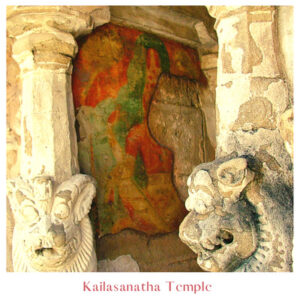A delightful glimpse of Pallava mural heritage


The unmistakable Ajanta style was in full bloom a 1000 km away in the ancient city of Kanchipuram, where the Pallavas were at the zenith of their glory during the 7th and 9th centuries. It is said that the walls of the Kailasanatha temple were once covered with paintings of brilliant colours, however most of them have vanished. Thanks to the efforts of the ingenious archaeological chemist Shri Paramasivan, a few fragments have survived.
The fragments at Kailasanatha along with the remnants at Talagishwara temple are quite significant – these are the only two surviving examples of the Pallava mural paintings. Further, they represent an important stage in the history of the development of South Indian paintings.
*The Masterpieces*

The Somaskanda panel, depicting Shiva and Parvathi with their son Karthikeya is the main iconographic motif of the temples built by the Pallavas in general. The term Somaskanda (Sa-Uma-Skanda) literally means (Shiva) “with Uma and Skanda”. Both have a pleasant countenance, and sit in a relaxed posture (sukhasana). The playful child Skanda is between the loving couple.

The only identifiable figure now visible on the Tagalesvara temple (Panamalai) walls is that of a beautiful looking, well-adorned graceful young lady standing beneath a royal parasol, wearing a tall bejewelled kirita (tiara) and jewellery, typical of the Pallava period. The skilful shading has endowed the figure a three-dimensional appearance. It is regarded as one of the most beautiful paintings of ancient India.
The mural heritage of Kanchipuram may not be the richest in India but the evolution of styles and multiplicity of forms and themes that developed at different periods of history under the patronage of different dynasties make it ever so fascinating!
